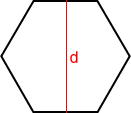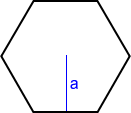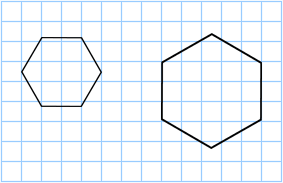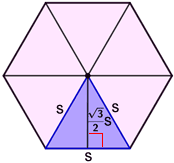Area of a hexagon
The area of a hexagon is the space contained within its perimeter. The grey space is the area of the hexagon in the figure below.

Area formula of a regular hexagon
There are many different types of hexagons. The most common type is a regular hexagon, which is a hexagon that has sides of equal length and angles of equal measure.
The area, A, of a regular hexagon can be found given only its side length, s, with the formula:
Example:
Find the area of a regular hexagon that has a perimeter of 72.
Given that the perimeter is 72, the length of each side of the regular hexagon can be found by dividing the perimeter by 6, making each side length 12.
Plugging the side length into the area formula:
Sometimes, in real life, it is easier to measure the distance between opposite sides of a regular hexagon. In such a case, the area of the hexagon is:

The apothem, a, of a regular hexagon is half of the distance between opposite sides of the hexagon. The area formula using the apothem is:

Finding area using a grid
Another way to find the area of a hexagon is to determine how many unit squares it takes to cover its surface. Below is a unit square with side lengths of 1 cm.

A grid of unit squares can be used when determining the area of a hexagon.

The grid above contains unit squares that have an area of 1 cm2 each. The regular hexagon on the left contains 6 full squares and 10 partial squares, so it has an area of approximately:
The regular hexagon to the right contains 17 full squares and 10 partial squares, so it has an area of approximately:
This method can be used to find the area of any shape; it is not limited to regular hexagons. However, it is only an approximate value of the area. The smaller the unit square used, the higher the accuracy of the approximation. Using a grid made up of 1 mm squares is 10 times more accurate than using a grid made up of 1 cm squares.
Derivation of the area formula

Divide the regular hexagon into six equilateral triangles by drawing line segments to opposite vertices. Each triangle has a side length s and height (also the apothem of the regular hexagon) of . The area, A, of one of the equilateral triangles, drawn in blue, can be found using:
Since there are six equilateral triangles, the area of a regular hexagon is:
